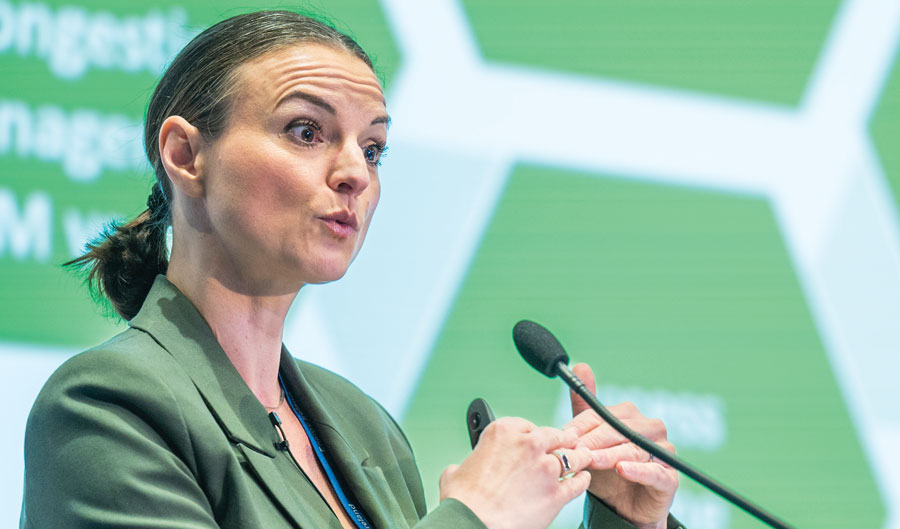
Navigating routes to market for offshore wind in Ireland: Opportunities and challenges
4th October 2024
Beyond ‘brown to green’
4th October 2024300GW of offshore wind energy by 2050

Catherine Banet, a professor of law at the University of Oslo and head of the Department for Energy of Resources Law and Academic co-director at the Centre on Regulation in Europe (CERRE) tells the Renewable Energy Magazine about the need for integrated grid development planning in order to scale up the European offshore wind sector.
Under the auspices of the Offshore Renewable Energy Strategy and the REPowerEU, the European Union is committed to a policy target of at least 300GW of offshore wind energy production capacity installed by 2050. Quickly after, in April 2023, North Sea countries announced a similar target for their sea basin alone by 2050. The ambitions are therefore high and on the increase.
In meeting this target, Banet identifies four key areas for targeted EU action to enable the scaling up of offshore wind:
1. planning;
2. permitting;
3. cross-border projects; and
4. promotion of mutual and local benefits.
Planning and permitting
Banet emphasises the need for integrated planning across the planning subsectors – maritime planning, climate planning, energy planning, and transport planning.
She says: “The different responsible planning authorities also need to cooperate. And we have the overall steering instrument of the governance of the energy union with national energy and climate plans.”
In tandem, Banet says that there is a need for an increase in the speed of permitting, explaining that while there are limited examples of integration of permitting processes between production and grid, that it is nonetheless not uncommon.
“We also need to simplify and speed up permitting for cross-border projects, including with hybrid grid solutions; this is key in enabling a cost-effective and environmentally sound development of offshore wind resources in Europe,” she says.
Promotion of mutual and local benefits
Banet further emphasises the importance of promoting mutual and local benefits in the form of coexistence among interests and sectors and the promotion of local benefits via non-pricing criteria in offshore wind auctions.
She says that the promotion of mutual and local benefits is “something that was very key to the announcements by the European Commission and Parliament in newly revised EU legislation (Renewable Energy Directive and state aid guidelines), as well as in the Net Zero Industry Act”.
Grid development with hybrids
Asserting that “we will need a change of speed in grid development”, Banet outlines that the EU has only managed to link 7 per cent of the 2050 targets for offshore generation capacity to date.
She adds that bridging this gap “requires increasing both generation and development at the same time”.
Banet continues: “This will require a change of grid architecture if we want to achieve these targets. We have traditionally developed offshore wind from a national approach with radial connections, but we need to move towards more multipurpose solutions – with hybrid projects combining production and interconnectors – and towards energy hubs or energy islands.”
Irish territory forms part of two of the European Network of Transmission System Operators’ (ENTSO-E) priority corridors for the development of offshore wind: the northern seas offshore grids, and the Atlantic offshore grid.
The University of Oslo professor states that, with specific projects having already been identified under the DMAP publications, there is an existing potential framework for Ireland to “move forwards from radial connections to a more interconnected energy system offshore”.
Banet adds that there is now a “broad consensus” in Europe that expansion of hybrid offshore wind projects will be better enabled by the use of offshore bidding zones instead of the home market approach. The risk of grid congestion for these projects, she argues, is better solved this way as it better reflects physical flows, and leads to a better price formation. However, Banet reflects that a role will remain for domestic market design in setting different rules for different offshore bidding zones across countries that may not all pertain to the EU. This requires legal clarification upfront, either through regulatory alignment or bilateral agreement between countries.
She further says that it is “less probable” that there will be a single regulator per sea basin, in spite of her advocacy for a centralised approach, although there will likely be high-level cooperation between regulators. Similarly, there will be most probably a cooperation between offshore transmission system operations (TSOs) than one TSO offshore.
“We will need to assess what are the cost and benefit remuneration models we have in terms of regular cost and incomes flows around sale of power, congestion, incomes, ancillary services, guarantees of origin,” she says. “All this comes on the top of market design rules, to complete the full picture of regulatory and market conditions for offshore wind with hybrids.
“In particular, when we introduce offshore building zones, we will need to adjust with supplementary tools such as remuneration mechanisms in the form of a support scheme, contract for difference, the revenue compensation mechanism proposed by the EU, or some type of offshore investment bank.
“Even if EU market design rules have just been revised, much remains to be clarified to enable hybrid projects. Not having the perfect regulatory regime now – if so exists – should not hamper the development of these projects. This is still a work in progress, but regulatory pathways exist to enable these projects on the short term. Issues related to anticipatory investments, grid connection regime and tariffs, and costs/benefits allocation models are among the ones that need to be clarified quickly.”
Cooperation and broad vision
The International Energy Agency (IEA) has stressed that development of energy projects must account for three main drivers:
1. economy;
2. security; and
3. environmental benefits.
Upon implementation of these drivers, Banet states that cooperation at European level between member states is key.
“We cannot overemphasise the importance of collaboration when it comes to developing power system in Europe,” she says.
“One of the things that we have learned from the disruptions created by the Russian invasion of Ukraine and before that is that countries manage better crises by cooperating with each other. It is because we have created cooperation through an integrated energy system that there has not been any blackouts in Europe.”
Concluding, Banet predicts that there are further developments and innovations yet to come which will enable a quicker rollout of offshore energy projects.
Accounting for this, she states that, as innovation continues to produce more options, there is a need for a future-proof market design “in order to ensure that there is an enduring and sustainable offshore wind industry”.
“We need a common regulatory approach for market design offshore that will open for connecting new projects, new productions such as hydrogen and new consumption. With that, hopefully we have a future proof market design for a power system that includes offshore wind,” she summarises.


